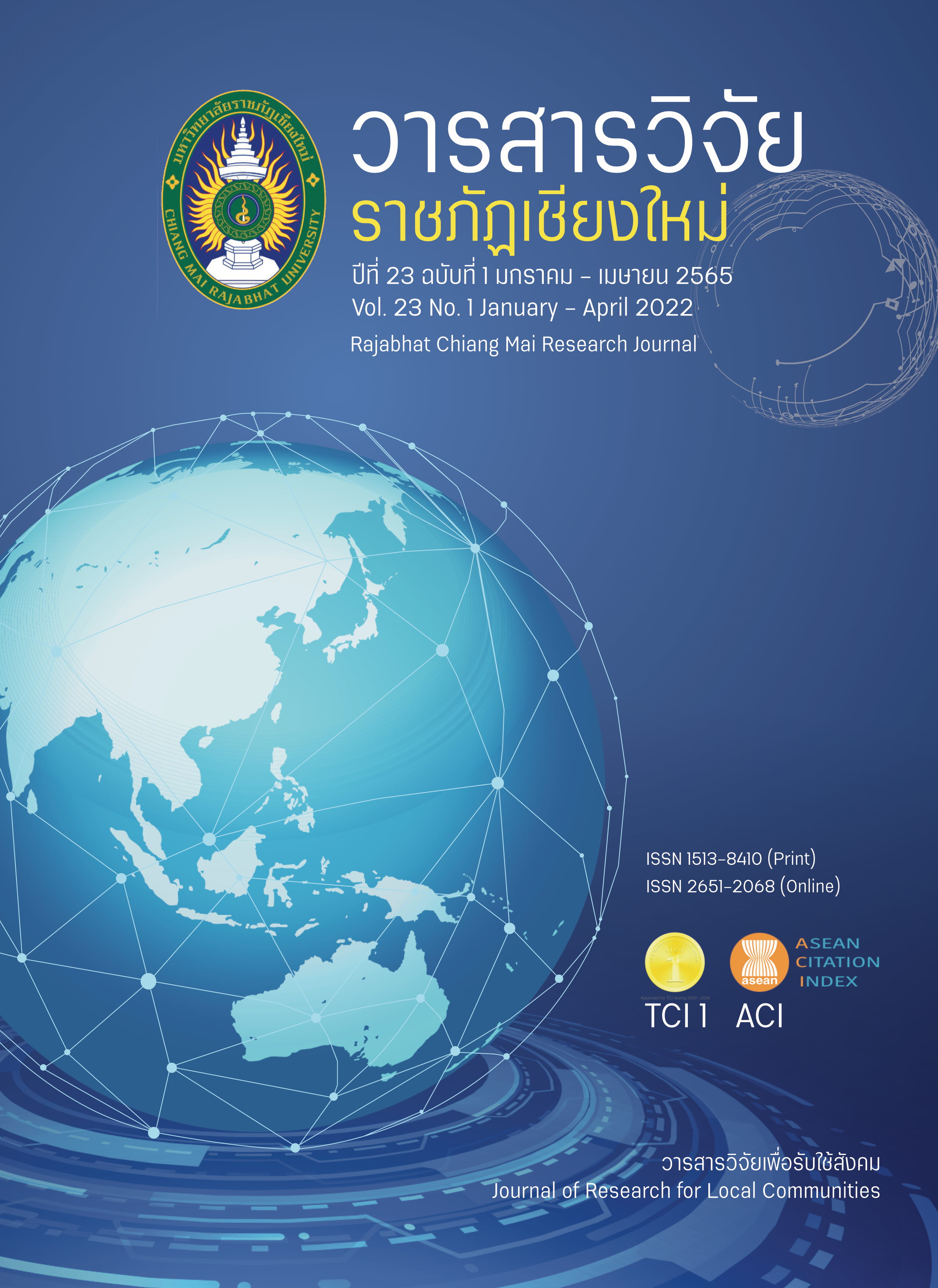สถานการณ์การให้บริการการแพทย์แผนไทยและการใช้ยาสมุนไพรของสถานบริการสาธารณสุขของรัฐในเขตสุขภาพที่ 2
DOI:
https://doi.org/10.14456/rcmrj.2022.247419คำสำคัญ:
สถานการณ์ให้บริการการแพทย์แผนไทย , สถานการณ์การใช้ยาสมุนไพร , ตัวชี้วัดบทคัดย่อ
การศึกษานี้มีวัตถุประสงค์เพื่อศึกษาสถานการณ์การให้บริการแพทย์แผนไทยและการใช้ยาสมุนไพรของสถานบริการสาธารณสุขของรัฐในเขตสุขภาพที่ 2 โดยวิเคราะห์ข้อมูลทุติยภูมิแบบภาคตัดขวาง จากการทบทวนข้อมูลย้อนหลังจากโปรแกรม HDC TTM Service ตั้งแต่ 1 ตุลาคม 2559 ถึง 30 กันยายน 2562 ซึ่งคัดเลือกกลุ่มตัวอย่างแบบเจาะจงเป็นประชาชนที่มารับบริการการแพทย์แผนไทยและใช้ยาสมุนไพรของสถานบริการสาธารณสุขของรัฐในเขตสุขภาพที่ 2 วิเคราะห์ข้อมูลเป็นค่าสถิติความถี่ (ร้อยละ) พบว่า สถานบริการของรัฐทุกจังหวัดในเขตสุขภาพที่ 2 มีร้อยละการให้บริการแพทย์แผนไทยเพิ่มมากขึ้นและผ่านเกณฑ์ตัวชี้วัดกระทรวงสาธารณสุขปี 2560-2561 ร้อยละ 18.5 และร้อยละ 19 ตามลำดับ โดยผู้ป่วยได้รับการวินิจฉัยโรค 5 อันดับแรก ประกอบด้วย ลมปลายปัตฆาตสัญญาณ 1 หลัง ลมปลายปัตฆาตสัญญาณ 3 หลัง ลมปลายปัตฆาตสัญญาณ 4 หลัง ลมปลายปัตฆาตขา ลมจับโป่งแห้งเข่า ปวดกล้ามเนื้อ ปวดขา/ปวดเข่า/ปวดเท้า อาการไอ และท้องอืด นอกจากนี้ พบว่า มีการสั่งใช้ยาสมุนไพรเพิ่มมากขึ้นทุกปี ประกอบด้วย ยาน้ำแก้ไอมะขามป้อม ยาน้ำเชื่อมแก้ไอมะขามป้อม ยาเม็ดประสะมะแว้ง ยาเม็ดอมมะแว้ง ยาแคปซูลฟ้าทะลายโจร และยาแคปซูลขมิ้นชัน ส่วนใหญ่เป็นยาในบัญชียาหลักแห่งชาติ คิดเป็นร้อยละ 49.33, 51.02 และ 58.92 ตามลำดับ ดังนั้นควรมีการวางแผนร่วมกันกับเครือข่ายและชุมชนในการให้ความรู้ประชาชนในการเข้าถึงบริการแพทย์แผนไทย และการใช้ยาสมุนไพร รวมถึงพัฒนาระบบบริการการแพทย์แผนไทยให้สอดคล้องกับนโยบายกระทรวงสาธารณสุข ผลลัพธ์ผ่านเกณฑ์ตามตัวชี้วัดกระทรวงสาธารณสุข รวมถึงประชาชนสามารถดูแลสุขภาพตนเองได้อย่างยั่งยืน
Downloads
เอกสารอ้างอิง
Announcement of the National Drug System Board. (2022). Government gazette Volume 139, Special Chapter 41 D. 18 February 2022. (In Thai)
Chaihomros N. (2021). The Comparative study of the effectiveness of the common Thai massage and the court-type Thai massage on pain at shoulder, neck and head, Nakhon Pathom Hospital. Journal of Traditional Thai Medical Research, 7(1), January-June. 67-83. (In Thai)
Constitution of the Kingdom of Thailand. Section 55. Government gazette Volume 134, Chapter 40 A. 6 April 2017. 15. Retrieved from http://www.ratchakitcha.soc.go.th/DATA/PDF/2560/A/040/1.PDF (In Thai)
Drug Act, B.E. (1967). Herbal Medicine. Retrieved from https://www.pharmacycouncil.org/share/file/file_1489.3.พระราชบัญญัติยาพ.ศ.2510_แก้ไข เพิ่มเติม.pdf (In Thai)
Harinawan P., Damnoenssawat W., Srikajang P., Maneewong N. (2009). Usage of Herbal Alternatives to Modern Medicine in Lampang Hospital and Community Hospitals in Lampang Province. Journal of Health Systems Research, 3(3), Jul.-Sept., 412-418. (In Thai)
Khun-Ngam P. (2017). The Study of Thai Massage Effects to Health-related Quality of Life of Working Age Group. (Master of Science in Department of Anti-aging and Regenerative Medicine, Dhurakij Pundit University. (In Thai)
Khunpitak P. (2016). Model of Thai Traditional Medicine Service in the Tertiary Public Health System of Regional Hospitals and General Hospitals in the 12th Area Health Service. (Master of Science in Health System Management, Prince of Songkla University. (In Thai)
Khunpitak, P., Thassri, J., & Nima, S. (2019). The Integration of Thai Traditional Medicine into the Health Service System at Tertiary Care Level in the 12th Area of Health Service. The Southern College Network Journal of Nursing and Public Health, 6(2), 42-52. (In Thai)
Manoy P., Kumfu S., Srithawong A. (2021). The effectof rice grain and Thai herbal hot pack on pain and back extensibility in persons with low back pain. Chiang Mai Medical Journal, 60(1), 75-86. (In Thai)
Meksawasdichai C. (2019). Evaluation of Policies Promoting the Use of Herbal Medicine in Hospitals in the Ministry of Public Health in Saraburi Province in 2017. Journal of Thai Traditional and Alternative Medicine, 17(3), 516-526. (In Thai)
National Health Reform Commission. (2017). Public Health Reform Plan. Retrieved from http://nscr.nesdb.go.th/wp-content/uploads/2018/10/07สาธารณสุข.pdf (In Thai)
National Economic and Social Development Board. (2017). National Economic and Social Development Plan No.12 Retrieved from https://www.nesdc.go.th/ewt_dl_link.php?nid=6422 (In Thai)
Nootim P., Sittikraipong K., Tungsukruthai P. (2019). Efficacy of Herbal Stream Bath in Reducing Muscle Pain: a Randomized Controlled Trial. Journal of Health Science, 28(Supplement 2), S101-S112. (In Thai)
Srirattayawong T., Weiangkham D., Petthai O., Somwan A. (2021). Naresuan Phayao Journal, 14(2), May-August, 51-61. (In Thai)
Strategy and Planning Division Office of the Permanent Secretary, Ministry of Public Health. (2017). Ministry Strategy Public Health 2017-2021. Retrieved from http://www.elnurse.ssru.ac.th/kanit_ng/pluginfile.php/178/block_html/content/แผน สุขภาพ%2012.pdf (In Thai)
Strategy and Planning Division Office of the Permanent Secretary, Ministry of Public Health. (2018). The 20-year national strategic plan (Public Health). Retrieved from http://bps.moph.go.th/new_bps/sites/default/files/Ebook%20MOPH%2020%20yrs%20final_240161.pdf (In Thai)
The Protection and Promotion of Thai Traditional Medical Knowledge Act, B.E. (1999). Thai Traditional Medicine. Government gazette Volume 116 , Chapter 120 A. 29 November 1999. 49-69. Retrieved from http://wwwlbo.moph.go.th/rxthai/rxthai1/law/law01.pdf (In Thai)
Vorapani, T., & Vorapani, P. (2013). The Study of Folk Medicine Healers Knowledge and Wisdom in Tak Province. Rajabhat Chiangmai Mai Research Journal, 19(1), 113-126. (In Thai)
World Health Organization. World Traditional Medicine Strategy 2014-2023. Page 1-78. (Online). Retrieved from https://apps.who.int/iris/bitstream/handle/10665/92455/9789241506090_eng.pdf?sequence=1 (In Thai)
ดาวน์โหลด
เผยแพร่แล้ว
รูปแบบการอ้างอิง
ฉบับ
ประเภทบทความ
สัญญาอนุญาต
ลิขสิทธิ์ (c) 2022 วารสารวิจัยราชภัฏเชียงใหม่

อนุญาตภายใต้เงื่อนไข Creative Commons Attribution-NonCommercial-NoDerivatives 4.0 International License.
1. บทความ ข้อมูล เนื้อหา รูปภาพ ฯลฯ ที่ได้รับการตีพิมพ์ใน “Community and Social Development Journal” ถือเป็นลิขสิทธิ์ของ Community and Social Development Journal มหาวิทยาลัยราชภัฏเชียงใหม่ และเพื่อให้เผยแพร่บทความได้อย่างเหมาะสมผ่านสื่อสิ่งพิมพ์และอิเล็กทรอนิกส์ ผู้เขียนยังคงถือครองลิขสิทธิ์บทความที่ตีพิมพ์ภายใต้ใบอนุญาต Creative Commons Attribution (CC BY) ซึ่งอนุญาตให้เผยแพร่บทความซ้ำในแหล่งอื่นได้ โดยอ้างอิงต้องอ้งอิงบทความในวารสาร ผู้เขียนต้องรับผิดชอบในการขออนุญาตผลิตซ้ำเนื้อหาที่มีลิขสิทธิ์จากแหล่งอื่น
2. เนื้อหาบทความที่ปรากฏในวารสารเป็นความรับผิดชอบของผู้เขียนบทความโดยตรง ซึ่งกองบรรณาธิการวารสารไม่จำเป็นต้องเห็นด้วยหรือร่วมรับผิดชอบใดๆ














